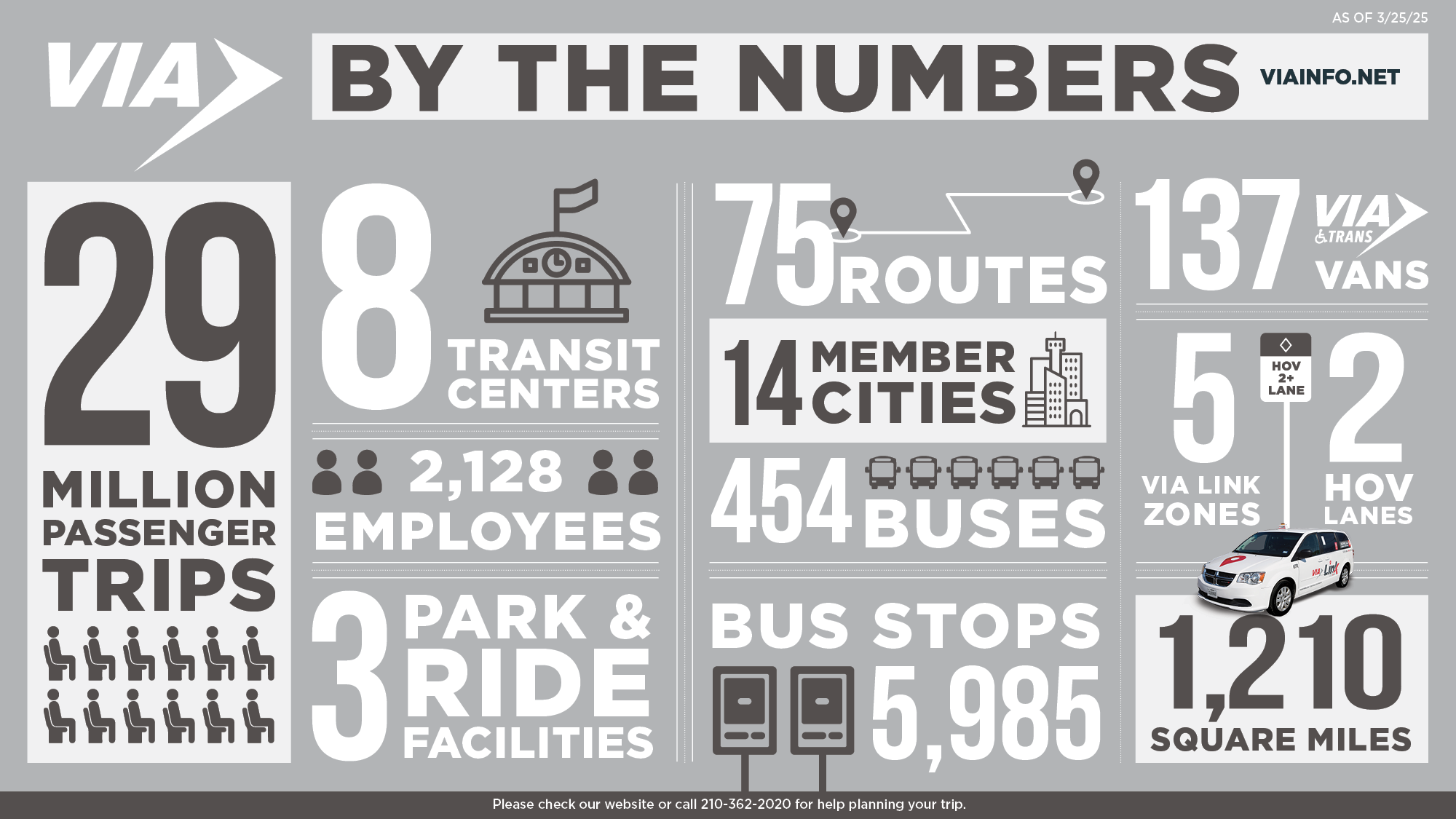| 2023 |
• VIA rolls out service with eight electric buses on daily routes.
• VIA opens the Advanced Rapid Transit Project Office as a community information hub on the future Green Line corridor, which will run from the San Antonio Airport to the South Side. |
| 2022 |
• VIA launches VIA Link service on the South Side with service to Texas A&M San Antonio, Palo Alto College, South Park Mall, and Toyota Motor Manufacturing.
• VIA's first Advanced Rapid Transit corridor, the Rapid Green Line, receives federal funding through inclusion in President Joe Biden's budget and Congress omnibus spending bill. |
| 2021 |
• VIA announces plans to expand its green transit footprint with the purchase of eight electric buses purchased with assistance of a federal grant.
• VIA replaces 117 of its 124 VIAtrans Paratransit vehicles with new, updated vans that feature enhancements for riders with disabilities and older adults. |
| 2020 |
• VIA adapts service during the COVID-19 global pandemic to provide essential service safely, ensuring San Antonio continued to move as the city went into a prolonged lockdown.
• VIA and CPS Energy announce renewable natural gas partnership.
• San Antonio voters approve 1/8-cent sales tax to support public transit programs in 2026 as part of the Keep SA Moving Plan.
• The first VIA-managed HOV lanes open in Bexar County. |
| 2019 |
• VIA introduces its first VIA Link zone with on -demand transit service on the city’s Northeast Side.
• The new Brooks Transit Center opens for service with new Prímo and Express routes that expand convenient, high-frequency service to one of the fastest-growing communities in the region.
• VIA adds two Prímo Routes - 102 Military and 103 Zarzamora - with fewer stops and faster service to destinations. |
| 2018 |
• VIA Metropolitan Transit is recognized by the Texas Transit Association (TTA) as the Outstanding Metropolitan Transit System in Texas for 2018 and receives the TTA’s Transit Innovation Award for its advancements in technology.
• VIA launches VIAtrans Online System that allows paratransit riders to Book new trips, save favorite trips for future bookings, view or cancel reservations, and see the current location of a scheduled vehicle in real time.
• VIA opens the Stone Oak Park & Ride, state-of-the-art facility at the corner of U.S. 281 N. and Stone Oak Parkway that features a full-service Customer Service Center, and 400 parking spaces on the three parking levels.
|
| 2017 |
• VIA begins a total fleet conversion to replace diesel buses with compressed natural gas (CNG) vehicles, which reduce NOx emissions by 97 percent.
• VIA launches the goMobile App designed to streamline planning, ticketing, and boarding process by providing real-time information and eliminating the need for cash payments and card swipes.
• VIA begins operating the largest CNG fueling station in North America, with 10 lanes and a 10,980-square foot compressor compound, which provides an estimated $8.5 million in annual fuel cost savings.
• VIA completes 1,000 bus stop improvements with new shelters installed throughout the service area to provide sheltered locations for 95 percent of boardings in the region. |
| 2016 |
• New VIVA service line launches with three distinct routes connecting cultural, historic, and entertainment corridors in the city center.
• VIA is recognized as the 2016 Outstanding Metropolitan Transit System by the Texas Transit Association for its efforts to enhance the region’s public transportation system.
• First new VIA mascots in 35 years are introduced, adding Primo and Safety Sofie as Buster's partners. |
| 2015 |
• VIA becomes the first major transit agency in the nation to offer free, system-wide 4G LTE WiFi.
• VIA opens Centro Plaza at VIA Villa, a state-of-the-art transit hub, just west of Downtown San Antonio. |
| 2013 |
• VIA Prímo service is extended into Leon Valley.
• VIA’s first all-electric, battery-powered buses enter service.
|
| 2012 |
• Primo service begins operating, offering the most frequent service in the VIA system at the time. |
| 2011 |
• VIA begins projects under the Long Range Comprehensive Transportation Plan. |
| 2010 |
• The agency’s first Compressed Natural Gas-fueled (CNG) buses and diesel-electric hybrid buses are introduced.
• Free, high-speed wireless internet connections are installed at VIA’s information centers. |
| 2009 |
• VIA enters into an agreement with CPS Energy to receive wind-generated electricity for all of the agency’s power needs.
• High-speed wireless internet connections are tested on VIA buses. |
| 2008 |
• Solar panels are installed on the Madla Transit Center to provide power for the facility. |
| 2007 |
• VIA begins selling passes and tickets online through the agency's website.
• VIA's website wins the AdWheel award from the American Public Transportation Association for "Best Internet Homepage." |
| 2006 |
• Installation begins on 700 new bus shelters.
• Vanpool service is introduced. |
| 2005 |
• VIA begins installing a special yellow seat dedicated to the legacy of Rosa Parks in each of its buses.
• VIA’s introduces new streetcars that are enclosed, air-conditioned, powered by propane engines, and accessible in accordance with the Americans with Disabilities Act. |
| 2004 |
• Voters in San Antonio approve the Advanced Transportation District.
• The Kel-Lac Transit Center opens.
• The National Committee for Employer Support of the Guard and Reserve recognizes VIA as a Five Star Employer.
|
| 2003 |
• VIA begins using ultra-low-sulfur diesel in new buses (40-foot) manufactured by New Flyer of America.
• VIA implements a new system of bus routes as a result of the Comprehensive Service Plan.
• The first of 400 new advertising shelters are installed.
• Construction begins on a new transit facility to replace the Kel-Lac Park & Ride facility. |
| 2002 |
• VIA's Customer Information Center at the Ellis Alley Park & Ride facility opens on the historic East Side, a result of combined conservation efforts with the S.A. Conservation Society and neighborhood group.
• VIA begins hiring officers for its Transit Police force. |
| 2001 |
• Work begins on the Comprehensive Service Plan, a system-wide assessment of VIA’s bus services that will result in increased productivity and efficiency
• Bicycle racks are installed on all VIA buses (excluding streetcars). New Automatic Vehicle Location (AVL) is introduced, using global positioning technology to track the activity of VIA’s fleet. |
| 2000 |
• VIA begins taking delivery of the agency’s first propane-powered buses (30-foot) manufactured by Champion. |
| 1999 |
• The River Walk Streetcar Station opens, a result of a partnership between VIA, the City of San Antonio, and the San Antonio Water System; the Streetcar Station provides the first public connection to the River Walk that is wheelchair-accessible.
• VIA’s first low-floor buses (40-foot) from North American Bus Industries are introduced. |
| 1998 |
• The Federal Transit Administration names VIA “Moving Kids Safely Champion” for its “Classroom on Wheels” program. |
| 1997 |
• VIA installs bicycle racks on buses as part of a pilot program, allowing bus patrons to take their bikes with them on bus trips for the first time.
• VIA introduces the Ozone Season Pass. |
| 1996 |
• VIA introduces Transit Bike Patrol to provide a safer transit environment for bus patrons in the downtown area. |
| 1995 |
• VIA receives Achievement Award for bus safety from the American Public Transit Association for the third consecutive year. |
| 1994 |
• VIA ranks second in the nation for cost-effectiveness by the University of North Carolina at Charlotte.
• VIA becomes charter member of CLEAR, a statewide environmental alliance. |
| 1993 |
• The Robert Thompson Transit Station opens, and VIA transports record numbers of passengers to Alamodome events, a service that continues today. |
| 1992 |
• VIA launches lift-equipped bus service with the introduction of wheelchair-accessible buses.
• VIA is one of the first transit agencies in the nation to adopt ADA standards. |
| 1991 |
• The TriParty project is completed. VIA receives its first award from the Government Finance Officers Association for Excellence in Financial Reporting. |
| 1990 |
• VIA is named Best Transit System in North America by the American Public Transit Association.
• VIA opens an on-site Child Development Center, the first of its kind in the transit industry. |
| 1988 |
• VIA introduces the Automated Vehicle Monitoring System, an innovative bus management and communication system capable of monitoring the activity of VIA’s fleet. |
| 1987 |
• VIA serves as the official transportation coordinator for Pope John Paul II's historic visit.
• For the third consecutive year, VIA receives the American Public Transit Association’s first place “Silver Award” for safety.
|
| 1985 |
• TriParty Plan to improve downtown transportation and pedestrian traffic is approved. |
| 1983 |
• VIA launches street car service downtown. |
| 1981 |
• VIA announces plans for downtown streetcar service. The San Antonio Streetcar is the result of years of design work by VIA, the San Antonio Conservation Society, and the Historic Review Board.
|
| 1980 |
• VIA mascots, the Buppets, including Buster the Bus, are introduced and begin appearing at area schools and community events as part of VIA’s educational and community outreach initiatives.
• The 25-foot Chance bus is introduced.
• VIA’s Maintenance department unveils a newly designed air-conditioning system aboard buses that sparks national interest. |
| 1979 |
• Residents in unincorporated areas of Bexar County and suburban cities of China Grove and Grey Forest vote in VIA service by a margin of 10 to 1. |
| 1978 |
• VIA begins operations. |
| 1977 |
• By a 5-to-3 margin, residents in San Antonio and five suburban areas vote to establish VIA Metropolitan Transit.
• Marilyn Jones is named VIA first Board Chair, and position she holds until 1981. |




